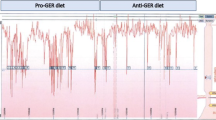Abstract
In order to evaluate whether combined esophageal and gastric pH-metry is feasible without interference due to the transcardial cable, four 24-hr ambulatory esophageal pH-metries were carried out in seven healthy volunteers in a randomized order. In two studies only one glass electrode was used. It was placed 5 cm above the lower esophageal sphincter. In the two other studies an additional electrode was placed in the corpus region 10 cm below the lower esophageal sphincter. In order to obtain a wide range of pH values, misoprostol (400 μg) was given at 9am and 9:15pm in two studies. In the two other studies placebo was given. Misoprostol exerted only a weak and short-lasting effect on gastric acidity. The four measuring conditions did not differ with respect to medians of esophageal reflux time and duration of single reflux episodes, Kendall's coefficient of concordance yielded a high reproducibility for both variables (P < 0.0025). Thus, combined esophageal and gastric pH-metry is feasible and highly reproducible.
Similar content being viewed by others
References
Little AG, DeMeester TR, Skinner DB: Combined gastric and esophageal 24-hour pH monitoring in patients with gastroesophageal reflux. Surg Forum 30:351–353, 1979
Little AG, Martinez EI, DeMeester TR, Blough RM, Skinner DB: Duodenogastric reflux and reflux esophagitis. Surgery 96:447–454, 1984
Bocquet A, Betrand A-M, Schirrer J, Raffi A: Intérêt de l'enregistrement simultané des pH oesophagien et gastrique chez le nourrisson. Pediatrie 41:17–32, 1986
Berezin S, Schwarz SM, Halata MS, Newman LJ: Gastroesophageal reflux secondary to gastrostomy tube placement. Am J Dis Child 140:699–701, 1986
Correnti FS, Little AG, Toccaceli S, Pappalardo G, Pitasi F, Castrini G: Gastroesophageal reflux due to naso-gastric tube.In Diseases of the Esophagus. JR Siewert, AH Hölscher (eds). Berlin, Springer, 1988, pp 1067–1072
Dajani EZ, Driskill DR, Bianchi RG, Collins PW, Pappo R: SC-29333, a potent inhibitor of canine gastric secretion. Am J Dig Dis 21:1049–1057, 1976
Hunt JN, Smith JL, Jiang CL, Kessler L: Effect of synthetic prostaglandin E1 analog on aspirin-induced gastric bleeding and secretion. Dig Dis Sci 28:897–902, 1983
Fimmel CJ, Etienne A, Cilluffo T, v Ritter C, Gasser T, Rey J-P, Caradonna-Moscatelli P, Sabbatini F, Pace F, Bühler HW, Bauerfeind P, Blum AL: Long-term gastric pH monitoring: Validation of a new method and effect of H2-antagonists. Gastroenterology 88:1842–1851, 1985
Pearson ES, Hartley HO: Biometrika Tables for Statisticians, Vol 2. Cambridge, University Press, 1972, pp 52–53
Streitberg B, Röhmel J: Exact nonparametrics in APL. Proceedings of the APL conference, Helsinki. New York, ACM 0-89781-137-7/84/006/0313, 1984, pp 313–325
Emde C, Garner A, Blum AL: Technical aspects of intraluminal pH-metry in man: Current status and recommendations. Gut, 22:1177–1188, 1987
Bontempo I, Corazziari E, Tosoni M, Ercole A: Reproducibility of esophageal pH-metric measurements. Gastroenterology 88:1331, 1985 (abstract)
Berges W, Baumgärtner U, Baum J, Ulrich B, Erckenbrecht J, Wienbeck M: Does postoperative gastric intubation promote gastroesophageal reflux? Gastroenterology 84:1103, 1983 (abstract)
Johansson K-E, Tibbling L: Evaluation of the 24-hour pH test at two different levels of the esophagus.In Esophageal Disorders: Pathophysiology and Therapy. TR DeMeester, DB Skinner (eds). New York, Raven Press, 1985, pp 579–582
Safaie-Shirazi S, DenBesten L, Zike WL: Effects of bile salts on the ionic permeability of the esophageal mucosa and their role in the production of esophagitis. Gastroenterology 68:728–733, 1975
Hopewood D, Bateson MC, Milne G, Bouchier IA: Effects of bile acids and hydrogen ion on the fine structure of esophageal epithelium. Gut 22:306–311, 1981
Cortesini C, Picciani F: Usefulness of combined gastric and esophageal pH monitoring in detecting gastroesophageal alkaline and mixed reflux. Eur Surg Res 16:378–383, 1983
Emde C, Cilluffo T, Bauerfeind P, Fimmel CJ, Blum AL: Effect of a slow-release formula of trimoprostil on intragastric acidity in healthy volunteers. Aliment Pharmacol Ther 2:135–141, 1988
Hawkey CJ, Walt RP: Prostaglandins for peptic ulcer: A promise unfulfilled. Lancet ii:1084–1087, 1986
Author information
Authors and Affiliations
Additional information
This work was supported by Swiss National Foundation grant 3.827.0.86 and by Deutsche Forschungsgemeinschaft grant Em 36/1-3.
Rights and permissions
About this article
Cite this article
Emde, C., Cilluffo, T., Bauerfeind, P. et al. Combined esophageal and gastric ph-metry in healthy volunteers influence of cable through les and effect of misoprostol. Digest Dis Sci 34, 79–82 (1989). https://doi.org/10.1007/BF01536158
Issue Date:
DOI: https://doi.org/10.1007/BF01536158




